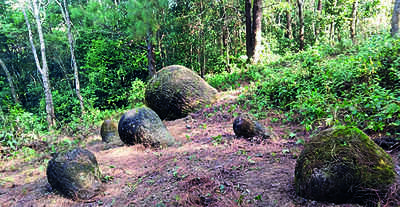Top Searches
- News
- City News
- guwahati News
- Australian Research Council to fund Assam jar study
Australian Research Council to fund Assam jar study

Guwahati: The Australian Research Council (ARC) will fund the exploration of the enigmatic megalithic jars that linked northeast India with South East Asia thousands of years ago.
Researchers at the Gauhati University (GU), North-Eastern Hill University (Nehu) along with their Australian counterparts are conducting a research study that establishes northeast India’s possible connections with Indonesia, Myanmar and Laos as early as the late second millennium BC.
Researcher Uttam Bathari said ARC has informed his team that it will give financial assistance for their study to explore the megalithic jars in Laos and India. Their field work titled, ‘An archaeological survey of the Assam stone jar sites’, compiled under lead researchers Tilok Thakuria of Nehu and Uttam Bathari of GU, which was published recently in the journal ‘Asian Archaeology’ stated that sandstone jars found scattered in the woodlands in Assam's Dima Hasao district have indicated their association with mortuary rituals performed in SE Asia. Based on the findings of the paper, the researchers have launched a new international project, Megalithic Connections: Imperilled Cultural Heritage in Laos and India. Some from the research team are carrying out the study in Laos under lead investigator Louise Shewan.
“This interdisciplinary project aims to document and explore the cultural connections between the geographically disparate megalithic cultures of Laos and India and create an enduring digital record of these threatened cultural assets,” Bathari told TOI.
He added that by integrating archaeological science and pioneering data capture technologies, the project will create globally significant new knowledge and advance heritage management processes including transferrable exploratory technologies. “It will further help underpin economic, social and cultural benefits in these regions. With an increasing awareness of the need to conserve global cultural assets, Australia will take the lead in developing breakthrough technological solutions and new cross-country research and practitioner capability,” said Bathari, an ethnohistory expert, at the GU history department.
Thakuria said the advanced level documentation under the ARC-funded project will include 3D modelling of the jar sites. “Documentation of each and every jar will have details so that researchers can go through these later,” he said. Thakuria said megalithic jar sites in Xiengkhuang in Laos and Assam’s Dima Hasao jar sites will be documented during the advanced study to be carried out by the researchers of GU, Nehu, Australian National University and Melbourne University. While Dima Hasao has an estimated 746 megalithic jars, the number in Laos is a little over 2,000.
The Plain of Jars in Xiangkhouang Province, Laos, was included in the list of World Heritage Sites by Unesco in 2019. But the researchers rued that very little research has been carried out in Myanmar and India. The jars in Dima Hasao were first described by James Philip Mills and John Henry Hutton, two civil servants who reported six jar sites in 1929. Some scholars later argued that the creators of Assam jars belonged to the Austro-Asiatic language family.
Researchers at the Gauhati University (GU), North-Eastern Hill University (Nehu) along with their Australian counterparts are conducting a research study that establishes northeast India’s possible connections with Indonesia, Myanmar and Laos as early as the late second millennium BC.
Researcher Uttam Bathari said ARC has informed his team that it will give financial assistance for their study to explore the megalithic jars in Laos and India. Their field work titled, ‘An archaeological survey of the Assam stone jar sites’, compiled under lead researchers Tilok Thakuria of Nehu and Uttam Bathari of GU, which was published recently in the journal ‘Asian Archaeology’ stated that sandstone jars found scattered in the woodlands in Assam's Dima Hasao district have indicated their association with mortuary rituals performed in SE Asia. Based on the findings of the paper, the researchers have launched a new international project, Megalithic Connections: Imperilled Cultural Heritage in Laos and India. Some from the research team are carrying out the study in Laos under lead investigator Louise Shewan.
“This interdisciplinary project aims to document and explore the cultural connections between the geographically disparate megalithic cultures of Laos and India and create an enduring digital record of these threatened cultural assets,” Bathari told TOI.
He added that by integrating archaeological science and pioneering data capture technologies, the project will create globally significant new knowledge and advance heritage management processes including transferrable exploratory technologies. “It will further help underpin economic, social and cultural benefits in these regions. With an increasing awareness of the need to conserve global cultural assets, Australia will take the lead in developing breakthrough technological solutions and new cross-country research and practitioner capability,” said Bathari, an ethnohistory expert, at the GU history department.
Thakuria said the advanced level documentation under the ARC-funded project will include 3D modelling of the jar sites. “Documentation of each and every jar will have details so that researchers can go through these later,” he said. Thakuria said megalithic jar sites in Xiengkhuang in Laos and Assam’s Dima Hasao jar sites will be documented during the advanced study to be carried out by the researchers of GU, Nehu, Australian National University and Melbourne University. While Dima Hasao has an estimated 746 megalithic jars, the number in Laos is a little over 2,000.
The Plain of Jars in Xiangkhouang Province, Laos, was included in the list of World Heritage Sites by Unesco in 2019. But the researchers rued that very little research has been carried out in Myanmar and India. The jars in Dima Hasao were first described by James Philip Mills and John Henry Hutton, two civil servants who reported six jar sites in 1929. Some scholars later argued that the creators of Assam jars belonged to the Austro-Asiatic language family.
FOLLOW US ON SOCIAL MEDIA
FacebookTwitterInstagramKOO APPYOUTUBE
Start a Conversation
end of article









